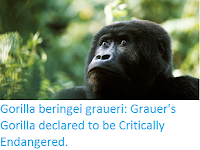There are currently six described species of non-Human Great Apes, the Chimpanzee, Pan troglodytes, the Bonobo, Pan paniscus, the Eastern Gorilla, Gorilla beringei, the Western Gorilla, Gorilla gorilla, the Sumatra Orangutan, Pongo abelii, and the Borneo Orangutan, Pongo pygmaeus. All of these are classified as either Endangered or Critically Endangered under the terms of the the International Union for the Conservation of Nature's Red List of Threatened Species, with the two Orangutan species, Asia's only Great Apes, considered to be particularly at risk due to the rapid rate of deforestation in Indonesia.
In a paper published in the journal Current Biology on 2 November 2017, a team of scientists led by Alexander Nater of the Department of Anthropology amd Department of Evolutionary Biology and Environmental Studies at the University of Zurich, and the Lehrstuhl für Zoologie und Evolutionsbiologie at the University of Konstanz, Maja Mattle-Greminger, also of the Department of Anthropology amd Department of Evolutionary Biology and Environmental Studies at the University of Zurich, Anton Nurcahyo of the School of Archaeology and Anthropology at the Australian National University, and Matthew Nowak of the Sumatran Orangutan Conservation Programme and Department of Anthropology at Southern Illinois University, describe a new species of Orangutan from the Batang Toro Forest of North Sumatra.
The new species is named Pongo tapanuliensis, meaning 'from Tapanuli', in reference to the three districts where it is found, North, Central, and South Tapanuli, all within the province of North Sumatra. The species is described from a male specimen killed in conflict with local villagers, which was initially determined to be different from museum specimens of the Sumatran and Borneo Orangutans based upon morphometric analysis (a tool used by palaeontologists, archaeologists,
anthropologists and forensic pathologists to analyse and compare
specimens, by taking numerous measurements of an object
such as a bone or shell, and comparing both these measurements and
ratios between measurements to those obtained from other specimens in
order to establish relationships between them) of the skull bones and teeth, then confirmed as a separate species by genetic sequencing.
A male Orangutan from the Batang Toro Forest. Sumatran Orangutan Conservation Program.
The population of Orangutans in the Batang Toro Forest is separated from other Orangutan populations on Sumatra by several hundred kilometres. It has previously been thought that this was the result of relatively recent habitat destruction by Human activity, but a molecular clock analysis of the three Orangutan species suggests that the ancestors of Pongo tapanuliensis diverged from the ancestors of the other two Orangutan around 3 380 000 years ago, while Pongo abelii and Pongo pygmaeus only split from one-another around 674 000 years ago.
The distributions of Pongo tapanuliensis (red) and Pongo abelii (yellow). ICUN Red List of Threatened Species.
Less than 800 Orangutans are thought to survive in the forests of Batang Toro, occupying an area of less than 1000 km². The species is found in both medium elevation hill and submontane forest, at altitudes of between 300 and 1300 m above sea level. These Orangutans clearly prefer untouched primary rainforest, where their population is densest, but is sometimes encountered in areas of mixed forest and agriculture around the edges of its range. The species is thought to have extended its range further to the south and west in the relatively recent past, but to have lost much of its range to Sumatra's rapid deforestation.
See also...
Follow Sciency Thoughts on Facebook.








